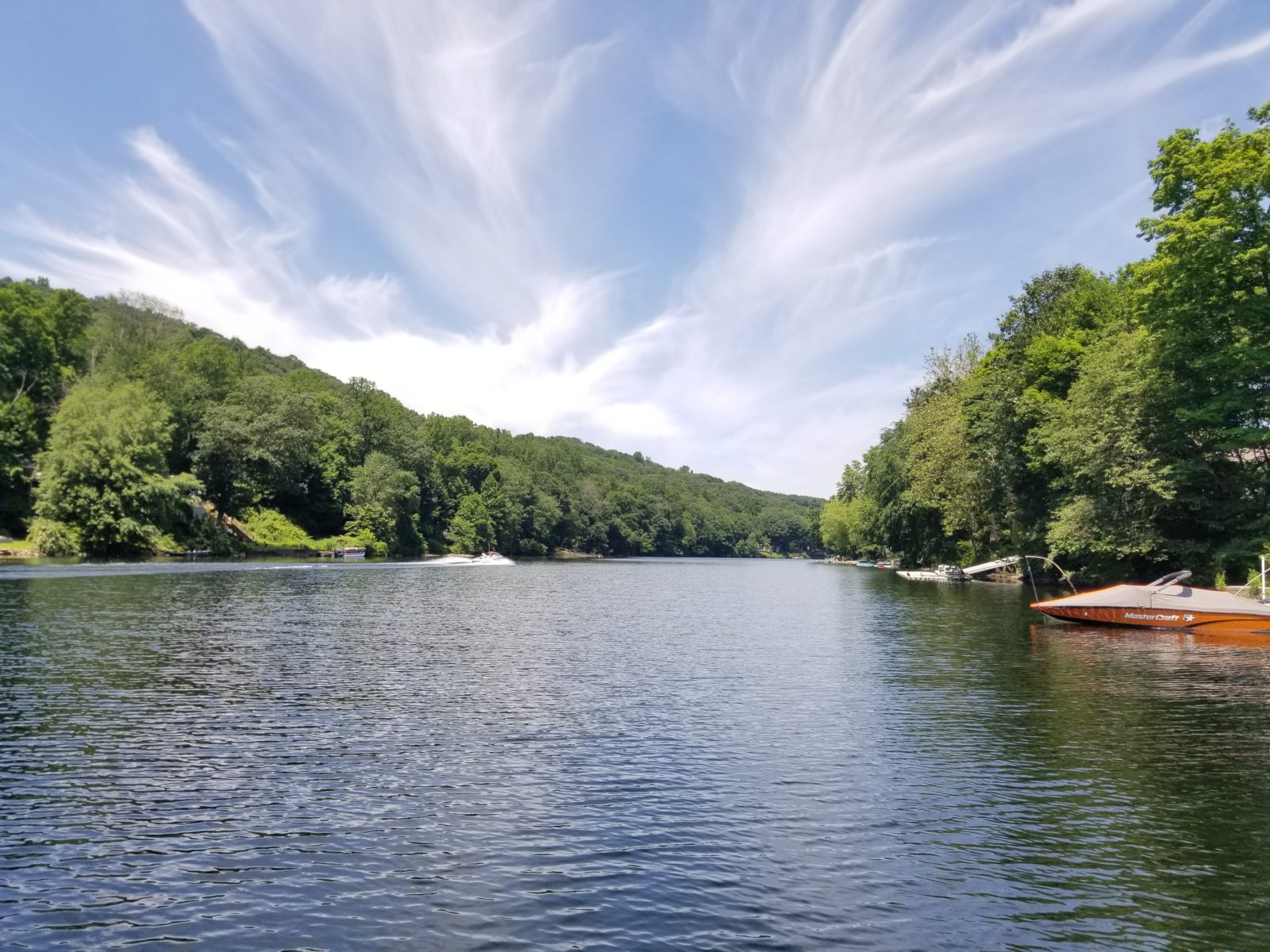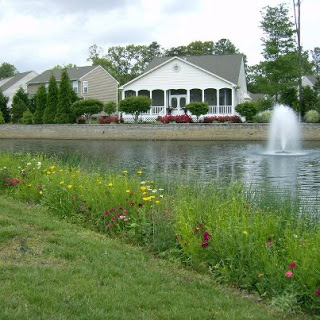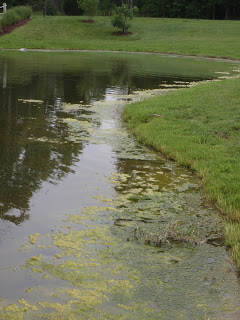By Industry Expert Greg Blackham, Aquatic Specialist
This is a subject I have wanted to write about for some time. More and more as I drive past various communities I’ve noticed an unhealthy trend in the way that riparian buffer zones around ponds are being mowed. In some instances I get this slash-and-burn feeling, almost as if the purpose of the buffer is not understood, and its very existence is shunned and should be hidden. I have to remind myself that when most people move in to a community, the purpose of the pond buffers is not completely understood. Unless residents specifically ask about the purpose, it is presumed the buffer is an area of poorly managed weeds and chaos. In the extreme this might be the case, yet even a wild jungle-like pond buffer would be better for the pond than no pond buffer.
Good buffer before destruction
At SŌLitude Lake Management, we have written many newsletter articles on why riparian buffer zones are important, so I will just briefly refresh the subject. I am more interested in illustrating the beauty and bio-diversity that comes with a large, healthy, and verdant system, even if it only changes a handful of peoples’ perceptions.
The buffer zone serves a multifold purpose. Erosion control may be arguably its primary benefit. A wide buffer can slow down and even stop sheet erosion depending on the severity. This is just surface water from a strong rain pushing soil, contaminates, and other particles downward in a wave. A tall buffer helps to combat rain impact erosion or “splash” erosion. This is simply the crater made in the soil when a rain drop hits the surface and loosens the soil that eventually joins the surface water heading towards the pond. Big, thick buffers also block and trap trash and organic materials trying to make their way to the pond. Lawn care providers, both professional and “DIY”, are notorious for sending leaves and grass clippings into a pond, even when they are being careful. Large buffers help to deter geese. The taller the vegetation, the more hesitant a goose will be to approach the pond in fear or a predator lying in wait. The list of practical benefits goes on, from nitrogen and phosphorous mitigation through uptake from herbaceous plants, to overall bank stabilization.
Buffer after destruction
When a vegetative buffer zone is repeatedly and systematically trimmed, it can rob the viewer of a beautiful arrangement of flowers. Most plants have an amazing array of flowers, even if there was no initial planting design. The native herbs and shrubs never get to display this expression when the buffer is constantly trimmed. It is such a waste of uniquity to see just a foot of green around a string of ponds, especially if mowed all the way to the ground. If I was a pond owner, I would want something to distinguish my pond from a swimming pool or a livestock watering hole. The monotony of the shoreline can be livened and highlighted with plants of varying heights and widths as the buffer creates a signature for the pond. The majority of ponds were created to handle and process stormwater, but that does not mean they need to look like mini wastewater processing plants!
With plant bio-diversity comes wildlife diversity. This has to be the most exciting aspects in experiencing a lush, unique buffer zone. As the vegetation grows tall and free, it attracts exponentially more wildlife than a routinely mowed buffer. You begin to see all manner of insects, birds, frogs, reptiles, and mammals as they move into what looks like a comfortable replication of areas they prefer naturally. Sure you will still have wildlife with a short neat buffer, but it will be sparse and cookie-cutter in nature. A lot of waterfowl need different levels of plant cover to attract them and only a few species will visit a pond with no buffer. Plant seed diversity will bring all types of foraging wildlife as well.
Buffers should be tall, wide and impacted sparingly. This does not mean that they do not need management. Invasive plants need to be rooted out systematically to prevent them from establishing a monoculture and/or overtaking the pond itself. Most people are familiar with phragmites and their aggressive tendencies. Other invasive plants should be dealt with using a similar low to no tolerance stance. In a lot of storm water situations, tree saplings need to be discouraged as well, especially on or around dams. In less structurally sensitive areas, small trees and shrubs can be encouraged, but the main thing you want to avoid is having trees grow tall and falling into the pond, taking a chunk of the shoreline with it. There are some situations where mowing/trimming should be done and this is on a case by case basis. If the vegetation is creating some type of hazard, undermining the integrity of the system, or impeding designed water flow areas, it may need to be trimmed or removed. Also, if the vegetation has grown so tall that you cannot see the pond anymore, you may want to give it a light trimming. Just remember that no matter how carefully you remove clippings, there will always be some portion of debris that will end up decomposing in the pond, so keep that in mind when considering how much to trim.
If your pond buffer consists of relatively unattractive vegetation, consult with your lake management company and let them know what you would like to achieve. They can recommend many types of native arrangements that can make your pond look more pleasing. I have stressed letting the buffer grow tall, but when the zone is only a couple of feet wide this can look very scraggly. An easy and inexpensive way to fix this is to increase the width. Tall herbs and grasses look a lot less raggedy in a 30’ width then they do in a 2’ width. This adjustment can also cut down on the turf that needs to be mowed and you may be able to get a discount on your landscaping management costs (or your labor if you mow it yourself!).
If you have always maintained your buffer zone at a very short height, and have now decided to let it grow, give it time to show its appeal. At first you might be uncomfortable with the look as it appears to be getting out of control. Once you start to see it for the unique ecosystem that it is, you can begin to enjoy the amazing flowers and wildlife that begin to sculpt the pond in a brilliant expression of nature at work. The pond will become much more than just a stop for storm water on its way to the next destination and a greater overall peace will resonate in the community as a small area of preserve is brought back into this world of development, concrete, and manicured hardscapes. Let it flourish!
Contact the experts at 888-480-5253 for all of your lake, pond and fisheries management needs.
Greg Blackham is an Aquatic Specialist with SOLitude Lake Management. Since 1998, SOLitude Lake Management has been committed to providing full service lake and pond management services that improve water quality, preserve natural resources, and reduce our environmental footprint. Services are available throughout the Eastern United States. Fisheries management consulting and aquatic products are available nationwide. Learn more about SOLitude Lake Management and purchase products at www.solitudelakemanagement.com.












